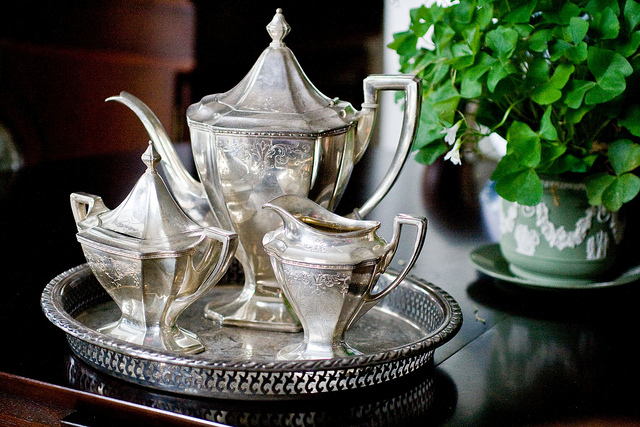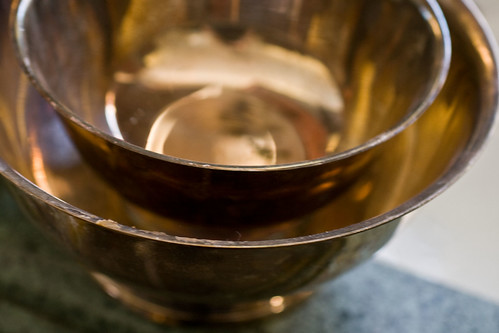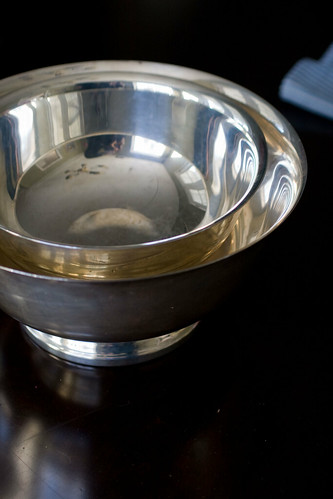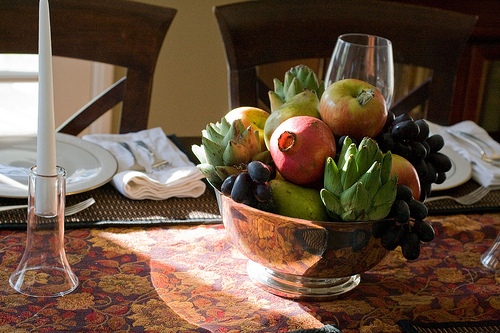I must have been an aristocrat in a past life (except for the politics) because I love traditional touches of silver around my home, like coffee sets, candlesticks, and a set of Revere bowls I collected on ebay years ago before my wedding. Apparently, however, I must have also had a household staff in that life (or at least a couple of footmen) because I loathe polishing silver. The cloths don’t work, the paste is smelly and disgusting, and the entire process is one I’d prefer to avoid.
Until I discovered this method of cleaning silver, which I have dubbed the “No muss, no fuss way to polish silver.” No special tools, no expensive pastes, and best of all NO elbow grease involved. The method follows:
Get a large tub which will fit your silver pieces entirely (I usually use one side of my divided kitchen sink). Line it with aluminum foil, shiny side up. Add equal parts of baking soda and salt (depending on the size of your tub — start with about a quarter to a half cup of each) and fill the tub with very hot water. Submerge your silver pieces in the hot water, make sure they are touching the foil and/or each other, and let sit until the tarnish has disappeared. Rub with a soft cloth to dry and brighten, and voila! No muss, no fuss tarnish free silver!
How does it work? The magic of chemistry. Tarnish is silver combined with sulfur, which is an ugly black. The aluminum has a better affinity to the sulfur than silver does, and the baking soda and salt solution act as a bridge which carries the sulfur back to the aluminum and off the silver (you’ll notice the sulfur smell!) The result is silver restored, and discolored aluminum foil. The best part is that unlike traditional polishing methods, this doesn’t remove any of the silver, so it’s better for antique silver and silver plate.
I could still use a couple of footmen, though.






Great tip – I’ll try this next time I need to polish something. Think it would work with jewelry too?
I have lots of silver and when I had someone to do it for me it was great. Now that I’m on my own, ugh!
I will try this method 🙂
What an excellent tip. Thank you so much! I have a pair of candlesticks passed down to me from my Grandma and my lazy attitude means they are in desperate need of a clean. I couldn’t bear the thought of cleaning them though!
Don’t have much silver but I can appreciate how pretty it is! Thanks for hosting yesterday. PS I left a green bowl there. Maybe I could come by next week and pick it up… GREG
Thank you. I’d sort of knew this worked from a daughter’s long ago science project. So, I cleaned everything silver and it worked like a charm. I’ve enjoyed your blog for a while. Mary
Thanks so much for the instructions. Lately, I’ve been noticing several silver things around the house in dire need of polishing. This will make it all come to pass far quicker than if I had to do it by hand!
Well if that isn’t awesome AND timely to know! Thanks!
very nice tip . i will definitely try this .
can I do this in my stainless steel sink? or would that interfere with the chemical reaction?
I believe Stainless Steel is nonreactive and shouldn’t affect this. As a disclosure, though, I’ve only tried it in a ceramic sink.
Hello, I have silver that I inherited when my Mom passed away almost 10 years ago. Today I have decided to pull some of it out so to say goodbye properly to Downton Abbey. The method above seems to be helping a little but the insides of the tea pot, sugar bowl and creamer dish are blackish looking on the inside. I couldn’t certainly put real food in these?? Does this mean that the silver needs to be replated?